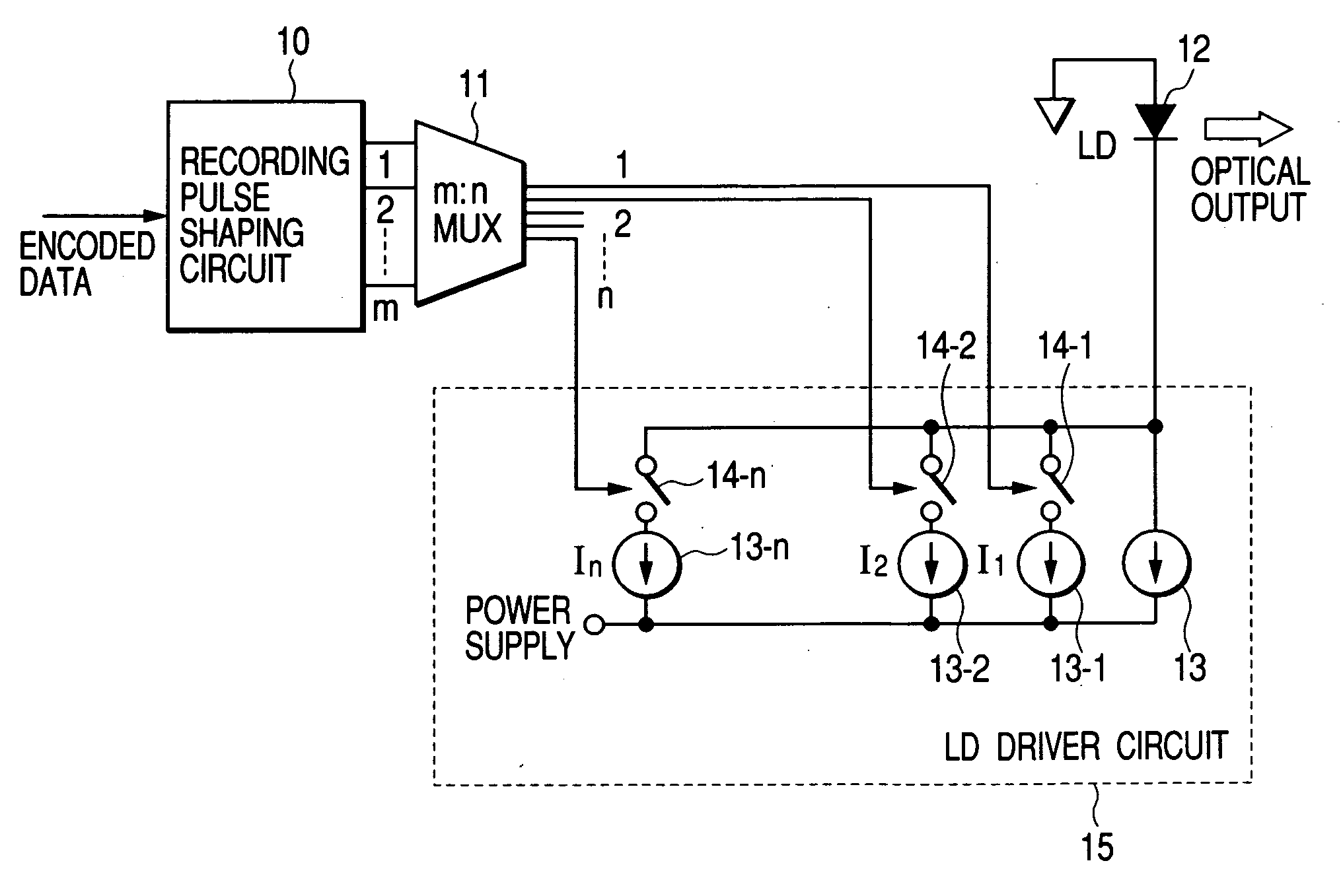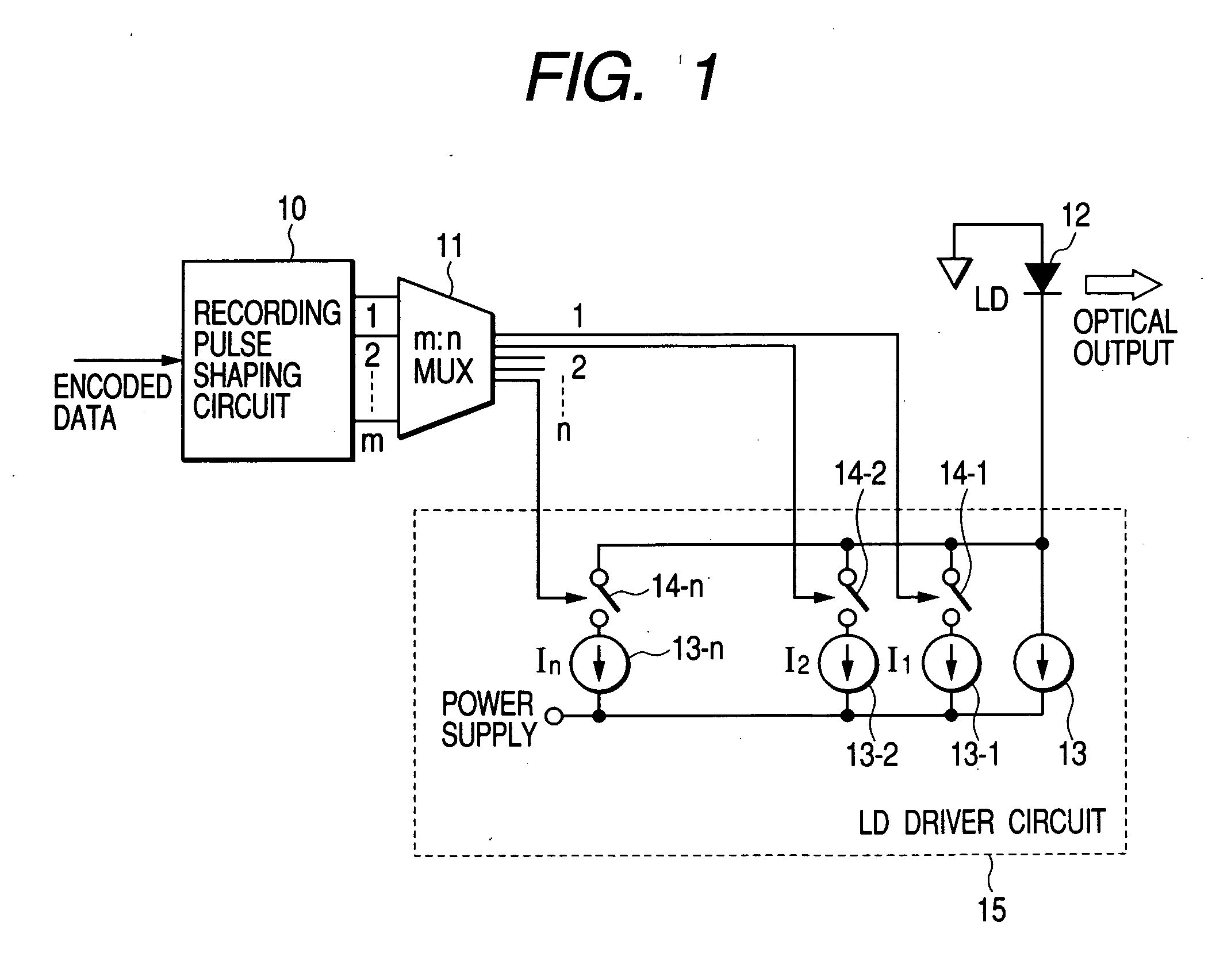Data recording method, data recording equipment and data recording evaluation equipment
a data recording and data recording technology, applied in recording signal processing, instruments, television systems, etc., can solve the problems of difficult to maintain timing accuracy less than hundreds of picoseconds, direct influence of conventional control methods, etc., and achieve high accuracy
- Summary
- Abstract
- Description
- Claims
- Application Information
AI Technical Summary
Benefits of technology
Problems solved by technology
Method used
Image
Examples
embodiment 1
[0044] [Embodiment 1]
[0045] A preferred Embodiment 1 of the invention wherein a 4:2 multiplexer is applied to generating multipulse signals is discussed, using FIGS. 7 through 9. FIG. 7A is a schematic diagram for explaining a flow of processing up to writing signals corresponding to data to be recorded on an optical disk. FIG. 7B is a schematic of a pulse shaping circuit. FIG. 8 is a schematic showing an example of the 4:2 multiplexer according to the present invention. FIG. 9 is an explanatory diagram showing an example of multipulse composition.
[0046] As shown in FIG. 7A, input data (data to be recorded) 22 is encoded by an encoding circuit 23 and a recording pulse shaping circuit 10 converts signals into which the data is encoded into signals to form a strategy for writing on an optical disk 24. The thus converted signals are signals programmed to be multiplexed and a sequence of four data signals Din1 to Din4 which are serially connected in order of 1 to 4 is input to the 4:2 ...
embodiment 2
[0051] [Embodiment 2]
[0052] A preferred Embodiment 2 of the invention wherein a 4:2 multiplexer is applied to generating multilevel signals is discussed. FIG. 10A is a schematic showing an equipment configuration example for generating a multilevel signal. FIG. 10B is a signal waveform diagram showing an example of 4-valued multilevel signal composition.
[0053] While a signal consisting of two values is output in Embodiment 1, Embodiment 2 enables output of a high-speed signal consisting of three or more values. As shown in FIG. 10A, input data is encoded into signals which are, in turn, converted into multilevel signals to be written on a disk. The thus converted signals are signals programmed to be multiplexed and input to the 4:2 multiplexer 11 from which two Dout1 and Dout2 signals are output. These two Dout1 and Dout2 output data signals which are synchronized and have even delay amounts are level converted by level converters 28-1 and 28-2, respectively, and then, combined thr...
embodiment 3
[0056] [Embodiment 3]
[0057] A preferred Embodiment 3 of the invention wherein the speed of n-pieces of output data signals from an m:n multiplexer is n times as much as the speed of input data signals and the n pieces of output data signals are at different speeds is discussed with reference to FIGS. 11 and 12. FIG. 11 is a diagram showing a write strategy example (with four power levels). FIG. 12 is a schematic showing one example of the m:n multiplexer according to the present invention.
[0058] If the strategy shown in FIG. 11 is required, a high positional accuracy is required for Pe and Pw1 which are programmed to form recording mark edges for edge recording, but the positional accuracy of Pw2 which is a medium level within the strategy need not be so high as Pe and Pw1. A configuration example of the m:n multiplexer that can meet this requirement is shown in FIG. 12.
[0059] A concrete instance where a 4T write strategy shown at the bottom of FIG. 11 is created is discussed. As ...
PUM
 Login to View More
Login to View More Abstract
Description
Claims
Application Information
 Login to View More
Login to View More - R&D
- Intellectual Property
- Life Sciences
- Materials
- Tech Scout
- Unparalleled Data Quality
- Higher Quality Content
- 60% Fewer Hallucinations
Browse by: Latest US Patents, China's latest patents, Technical Efficacy Thesaurus, Application Domain, Technology Topic, Popular Technical Reports.
© 2025 PatSnap. All rights reserved.Legal|Privacy policy|Modern Slavery Act Transparency Statement|Sitemap|About US| Contact US: help@patsnap.com



